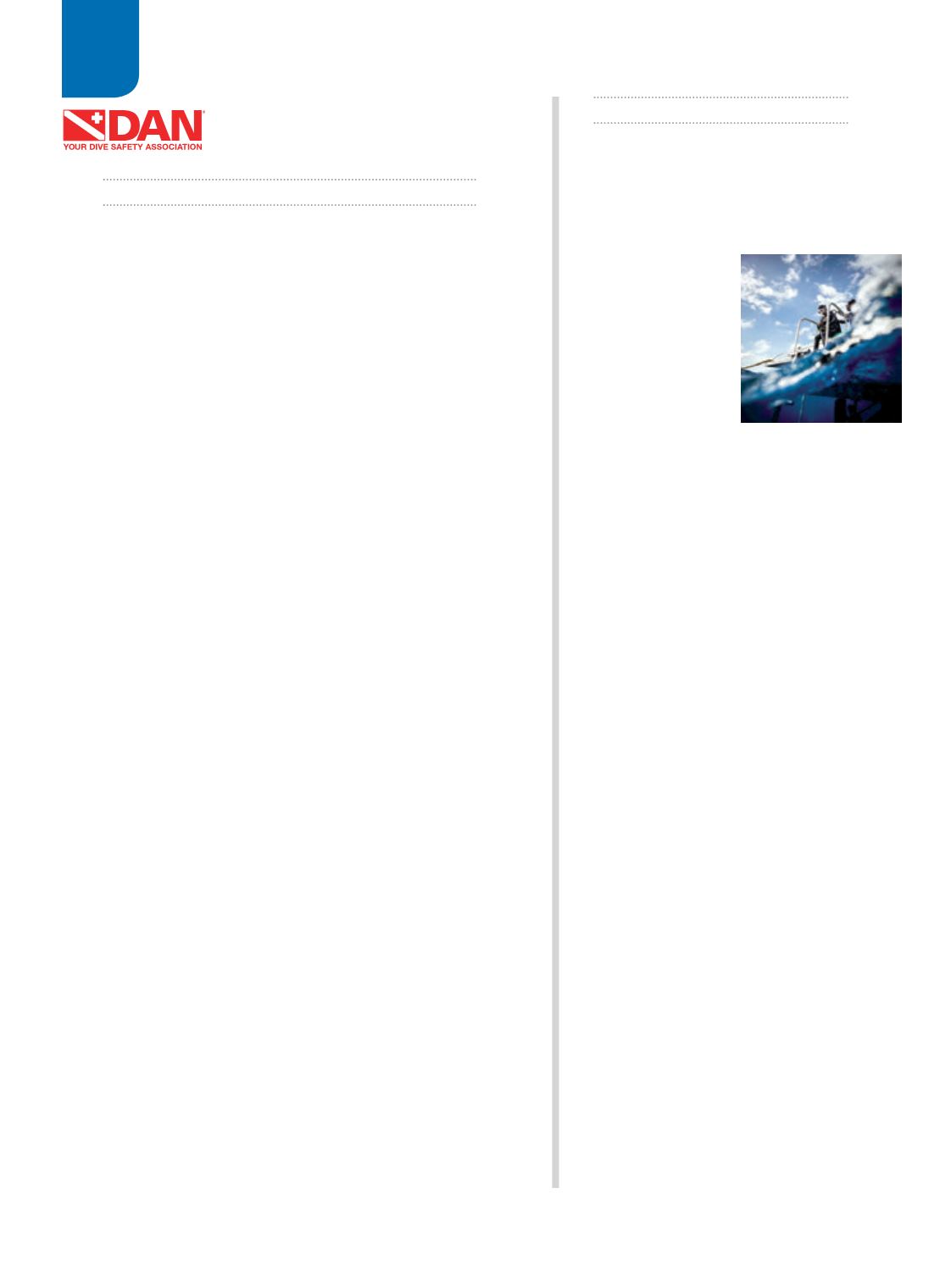

32
|
WINTER 2017
DIVE SLATE
DAN PSA, PROGRAMS AND TRAVEL
PUBLIC SAFETY ANNOUNCEMENT
D
ive professionals
are critically
important to
enhancing safety
in the dive community.
For this reason, DAN
®
has
created a new Professional
Membership program, which is now available to
dive leaders, instructors, owners and operators. The
program features a variety of products and services
designed to protect these professionals as well as
their students, staff and businesses.
PREPARED DIVER PROGRAM
All DAN Professional Members now have access to the
Prepared Diver program, a video-based course created
specifically to address the five leading preventable
factors in diver injury and death. Prepared Diver
complements all entry-level and refresher courses and
provides additional insight into the science underlying
fundamental diving skills.
STUDENT MEDICAL INSURANCE COVERAGE
At no cost to the professional or student, this
new insurance program provides up to $25,000
in coverage for medical expenses for injuries that
occur during entry-level courses.
RISK-MITIGATION RESOURCES
Risk will always exist; how you plan for and react to
it is what matters. As your dive safety association,
DAN has a responsibility to provide Professional
Members with the education and services required
to mitigate the risks and reduce the liabilities
associated with diving
DIVE SAFETY PUBLICATIONS AND RESOURCES
DAN Professional Members have access to an
extensive collection of resources, including
scientific studies, workshop proceedings and
reports, and analysis of diving incidents and
fatalities. DAN also offers its suite of first-aid
training programs, now delivered via a new
eLearning platform.
To learn more about this program, email
ProfessionalMember@DAN.org .CARDIOVASCULAR
RISK FACTORS
H
eart disease is the leading cause
of death in the United States,
responsible for approximately one
in every four deaths. It is also
one of the leading causes of scuba diving
deaths, with about one-third of all diving
fatalities associated with acute cardiac
events. Because the health of your heart
and circulatory system are essential to
your safety while scuba diving, take time
to learn more about your cardiovascular
risk factors.
HYPERTENSION
Thirteen percent of deaths caused by
cardiovascular disease can be attributed
to hypertension (high blood pressure).
The first number of your blood pressure,
the systolic pressure, should be below
120 mmHG. Every mmHG above 120
raises your risk of premature death.
As long as your blood pressure is
under control, the relevant dive-fitness
concerns are hypertension-related organ
damage and the side effects of any
blood pressure medications.
SMOKING
Smoking is the single most deadly
preventable cardiovascular risk factor.
It increases your risk for coronary heart
disease, peripheral vascular disease,
stroke, sudden cardiac death, cancer
and other conditions. It affects your
breathing and exercise tolerance,
increases your blood pressure and lipid
levels and can result in sustained, low-
level inflammation that causes your
cardiovascular system to deteriorate.
HYPERLIPIDEMIA
Cholesterol, a lipid found in the blood
and all the body’s cells, does not
dissolve in blood by itself and must
be combined with proteins to form
low-density lipoprotein (LDL) and high-
density lipoprotein (HDL). Too much LDL
leads to narrowing and stiffening of the
arteries and can as much as double
your 10-year risk of dying. Working with
your physician, aim to maintain a total
cholesterol of 200 mg/dL or lower and
an LDL of 100 mg/dL or lower.
INACTIVITY
Regular exercise helps maintain health
and capacity for sustained exercise,
both of which are necessary to keep
you safe in the water. Inactive people
are nearly twice as likely to develop
heart disease. To protect your heart,
exercise for at least 30 minutes a day,
five days a week. To increase your
exercise capacity, exercise more often
and more vigorously. If you are currently
sedentary, consult your physician before
you begin exercising.
OBESITY
Obesity can lead to increased blood
pressure, blood glucose and lipid levels
and can result in other conditions.
Abdominal obesity (a waist circumference
of 40 inches or more for men or 35 inches
or more for women) carries the greatest
risk. Obese divers may also have difficulty
with buoyancy control and may exert
themselves more while diving, which puts
extra strain on the heart.
The presence of these risk factors
does not guarantee that you will
develop cardiovascular disease, but
the more risk factors you have, the
more vulnerable you are. For more
information, visit
DAN.org/Health .PROGRAM SPOTLIGHT
DAN PROFESSIONAL
MEMBERSHIP
PROGRAM


















